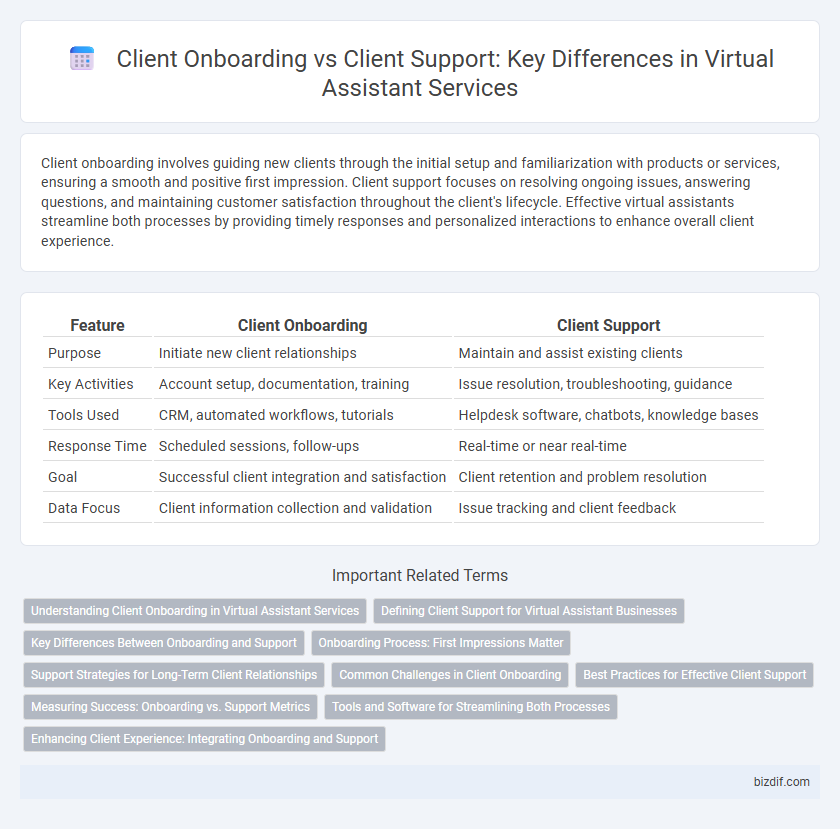Client onboarding involves guiding new clients through the initial setup and familiarization with products or services, ensuring a smooth and positive first impression. Client support focuses on resolving ongoing issues, answering questions, and maintaining customer satisfaction throughout the client's lifecycle. Effective virtual assistants streamline both processes by providing timely responses and personalized interactions to enhance overall client experience.
Table of Comparison
| Feature | Client Onboarding | Client Support |
|---|---|---|
| Purpose | Initiate new client relationships | Maintain and assist existing clients |
| Key Activities | Account setup, documentation, training | Issue resolution, troubleshooting, guidance |
| Tools Used | CRM, automated workflows, tutorials | Helpdesk software, chatbots, knowledge bases |
| Response Time | Scheduled sessions, follow-ups | Real-time or near real-time |
| Goal | Successful client integration and satisfaction | Client retention and problem resolution |
| Data Focus | Client information collection and validation | Issue tracking and client feedback |
Understanding Client Onboarding in Virtual Assistant Services
Client onboarding in virtual assistant services involves systematically gathering essential client information, setting expectations, and customizing workflows to ensure seamless service delivery. This phase establishes clear communication channels and aligns the virtual assistant's capabilities with the client's specific needs, enhancing efficiency and satisfaction. Unlike ongoing client support, onboarding is a structured process that lays the foundation for successful long-term collaboration.
Defining Client Support for Virtual Assistant Businesses
Client support in virtual assistant businesses involves providing ongoing assistance and troubleshooting to clients after onboarding, ensuring seamless communication, timely responses, and resolution of issues. It focuses on maintaining client satisfaction, managing expectations, and handling routine tasks or inquiries to enhance the overall client experience. Effective client support helps build long-term relationships, fostering trust and encouraging client retention.
Key Differences Between Onboarding and Support
Client onboarding involves the initial process of integrating new clients by setting up accounts, providing product training, and ensuring a smooth start to the service experience. Client support focuses on ongoing assistance, resolving issues, answering questions, and maintaining client satisfaction throughout the customer lifecycle. The key difference lies in onboarding being a proactive, one-time introduction phase, whereas support is reactive and continuous throughout the client relationship.
Onboarding Process: First Impressions Matter
The onboarding process sets the foundation for client relationships by ensuring a seamless and engaging introduction to services, which directly impacts retention and satisfaction. Effective virtual assistant strategies during onboarding include personalized communication, clear instructions, and timely follow-ups that build trust and confidence. Prioritizing first impressions in client onboarding distinguishes a brand and paves the way for long-term support success.
Support Strategies for Long-Term Client Relationships
Effective client support strategies prioritize personalized communication and proactive issue resolution to foster trust and loyalty. Implementing a robust follow-up system and utilizing CRM tools enhance relationship management and anticipate client needs. Continuous training for virtual assistants ensures adaptability in handling diverse client concerns, reinforcing long-term engagement.
Common Challenges in Client Onboarding
Client onboarding often faces challenges such as incomplete data collection, unclear communication of expectations, and delayed document submission, which can hinder smooth service initiation. In contrast, client support primarily deals with resolving ongoing issues and maintaining satisfaction post-onboarding. Efficient virtual assistants streamline client onboarding by automating form filling, sending timely reminders, and providing real-time guidance to minimize onboarding delays and errors.
Best Practices for Effective Client Support
Implement seamless client onboarding by providing clear instructions, personalized communication, and setting expectations early to enhance client satisfaction. For effective client support, prioritize timely responses, active listening, and use data-driven insights to resolve issues efficiently. Leveraging AI-powered virtual assistants can streamline both onboarding and ongoing support, improving client retention and experience.
Measuring Success: Onboarding vs. Support Metrics
Measuring success in client onboarding involves tracking metrics such as time-to-activation, completion rates of onboarding tasks, and user engagement levels during initial setup. In contrast, client support metrics emphasize response time, resolution rates, customer satisfaction scores (CSAT), and repeat contact frequency. Distinguishing these key performance indicators (KPIs) enables virtual assistants to optimize client experience by addressing both the effectiveness of early engagement and ongoing support quality.
Tools and Software for Streamlining Both Processes
Client onboarding utilizes software such as CRM platforms, document automation, and e-signature tools to efficiently capture and verify client information while setting up accounts. Client support relies on helpdesk systems, live chat software, and ticketing solutions to manage inquiries, resolve issues, and track customer interactions in real time. Integrating platforms like Zendesk, HubSpot, and Freshdesk streamlines workflows by allowing data sharing and seamless communication between onboarding and support teams.
Enhancing Client Experience: Integrating Onboarding and Support
Integrating client onboarding with ongoing support streamlines the client journey, ensuring a seamless transition from initial engagement to continued service. Virtual assistants play a crucial role in personalizing interactions, quickly addressing inquiries, and providing consistent guidance throughout the client lifecycle. This unified approach boosts client satisfaction, retention, and overall experience by delivering timely, relevant assistance at every stage.
Client onboarding vs Client support Infographic

 bizdif.com
bizdif.com